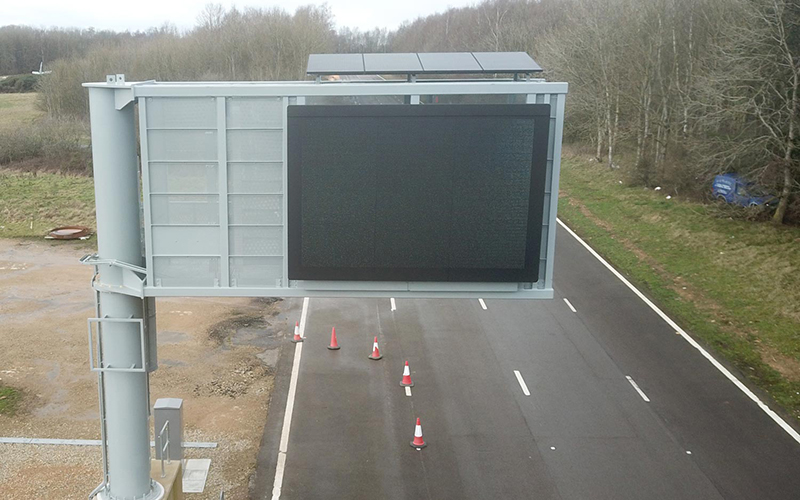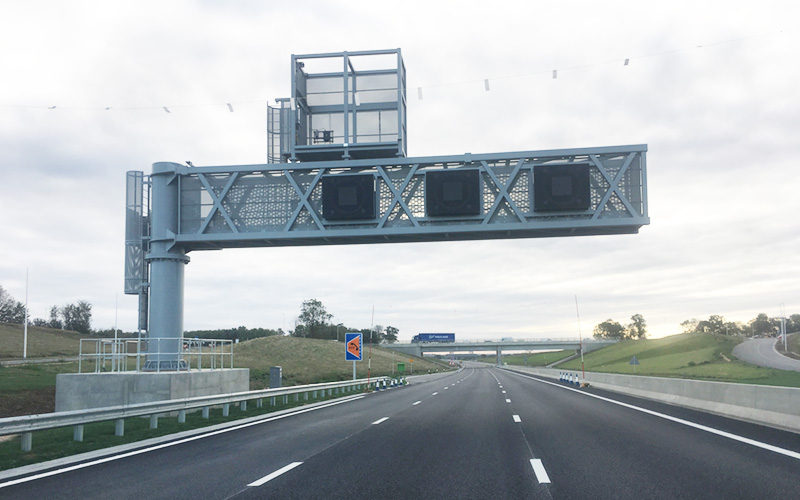Gantries for National Highways
4. Design challenge and approach
The design submission requires proposals for a visual identity for maintenance accessible gantries on the major road network.
The successful design will need to demonstrate:
- a rationalised design that will contribute to the visual consistency and simplified look of the network to address the balance between form and function where emphasis is currently heavily towards functional design
- enhanced road user experience
- sympathy to the local environment, consideration of how the structures interact with settings, from urban to countryside
- opportunities to achieve efficient processes in design and construction
- opportunities to improve sustainability through reduced energy and resource consumption
- aspects of the concept that could be retrofitted to existing structures to create a shared appearance
The current standardised Cantilever Gantry
 The current standardised Cantilever Gantry
The current standardised Cantilever Gantry
Super-span Cantilever Gantry
 Super-span Cantilever Gantry (during A14 construction)
Super-span Cantilever Gantry (during A14 construction)
Whilst this competition is looking for a maintenance accessible gantry family design identity, the immediate requirement is for the creation of a standardised design for the Cantilever and Super-span Cantilever variants (as shown above) so submissions should concentrate on these structures. Consideration of how the design themes can be aligned to the wider family, Super-span Portal and Portal gantries, is also required but only to a level to illustrate a consistent family approach.
Primarily proposals are sought for new structure designs, but the competitor is asked to consider if the design concept could be applied to the existing gantries on the network. Where this is feasible then ideas to simply and practically apply key aspects of the proposed gantry family design theme to existing structures are invited.
There will be two sequential stages relating to the development of a new gantry family. The first (this competition) will be to generate a range of architectural interpretations from which a judging panel will identify a preferred design approach. Following this design contest, it is intended that the competition winner will be invited to enter into contract with National Highways for the subsequent technical design phase.
The second phase will produce a full technical design for the Cantilever and Super-span Cantilever gantries. This work shall be led by a nominated structural engineer who shall be identified and contracted to National Highways through a separate competition via the Specialist Professional and Technical Services (SPaTS2) framework. Consequently, any party participating in this architectural design competition shall be excluded from participating in the Gantries Structural Design competition.
The winner of the design contest will be invited to work alongside the nominated structural engineer to produce detailed designs. Both parties will work together to develop the architectural concept into a spatially coordinated design and test this against the technical requirements and relevant standards and regulations. The information at the end of this stage needs to be coordinated sufficiently to avoid all but the most minor of iterations at the following stage, to develop a full technical design, where it is anticipated that only review and ad hoc support will be required from the winner of the architectural design contest competition.
Strong collaborative behaviours and the ability to work in partnership will be essential in the technical design phase and applicants should consider how they will work with the structural engineer.
Responsibility for all second phase work shall be that of the structural engineer, to ensure the designs are safe, comply with relevant standards and regulations, and are feasible for manufacture, installation and operation. Designs will comply with The Design Manual for Roads and Bridges (DMRB) which provides standards relating to the design, assessment and operation of major roads in the UK. This work will be monitored and supported by a National Highways review team to ensure the detailed design aligns with the requirements of the competition brief by using their advice, experience and subject matter knowledge. Downstream these designs will be checked by an independent structural engineer to provide assurance that they meet the requirements.
